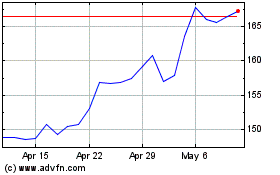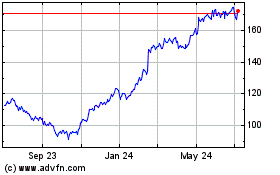US Casual-Dining Companies Explore Smaller-Format Restaurants
February 17 2011 - 11:54AM
Dow Jones News
Casual-dining companies, such as Cheesecake Factory Inc. (CAKE)
and Texas Roadhouse Inc. (TXRH), are experimenting with smaller
restaurant prototypes as a way to improve margins coming out of the
recession.
Cheesecake Factory is working on a new 8,000-square-foot model,
which it expects to generate similar cash flow margins as its
typical 10,000-square-foot locations. The cash investment required
for the smaller-format restaurants is reduced by more than 20%,
allowing the restaurant to reach peak margin levels with lower
sales. With the new model, Cheesecake Factory said it can exceed
20% return on investment with sales volumes of just over $8
million.
The smaller prototype also provides more site-selection
flexibility, said Chief Executive David Overton, during a
conference call. "We don't require only new mall development or
expansion of malls to build new restaurants," he said. "This is a
big advantage."
Smaller spaces require less capital investment, increase
efficiency, and make chains more adaptable to existing retail
space, at a time when new sites are hard to come by and restaurant
traffic still hasn't returned to pre-recession levels.
Texas Roadhouse is testing a 10% smaller version, which opened
last month.
"The smaller prototype certainly reduces development costs, but
it also allows us to open in some smaller markets that may not be
able to support a full-size restaurant," a spokesman said.
Often, these smaller markets can be more profitable because they
offer cheaper real estate and less competition in the steakhouse
category.
"Also, designing and working on the new prototype helped us to
identify some inefficiencies in the kitchen, which we will
incorporate in all new units [big or small] going forward," the
spokesman added.
Bill Fahy, senior restaurant analyst at Moody's, said that,
because restaurant companies reduced costs so drastically in the
downturn, it will be tougher to downsize now. "There's always ways
to cut costs," he said. "The biggest challenge is cutting costs
without impacting the customer experience."
The restaurant companies said they can cut square footage in
non-revenue-producing areas such as kitchens and waiting areas to
allow for a similar amount of seating as in larger models, creating
better margins.
WD Partners, a Columbus-based restaurant design and development
firm, estimated that reducing a restaurant's size to 7,250 square
feet from 8,100 square feet through engineering improvements could
save $153,000 per unit in development costs alone.
Dennis Lombardi, WD Partners' executive vice president of
food-service strategies, said reductions in the back of the
restaurant, or "house," if done right, "won't just avoid a negative
impact on customers, but can actually improve the customer
experience." Adding tables to waiting areas shortens wait times,
and decreasing kitchen size reduces the fatigue factor for
employees, he noted.
Darden Restaurants Inc. (DRI), which owns Olive Garden, Red
Lobster and Longhorn Steakhouse, is exploring a similar strategy
with a multi-brand restaurant opening March 7 in Florida. The
combination Olive Garden/Red Lobster includes a joint kitchen and
two separate dining rooms that are each about half the size of a
typical restaurant.
"It allows us to go in to new markets, which normally wouldn't
have the traffic to support one of our full-size restaurants," a
spokesman said.
P.F. Chang's China Bistro Inc. (PFCB) recently hired a new vice
president of real estate for its Pei Wei chain and is evaluating
alternatives to the chain's typical 3,200-square-feet design. With
fewer malls and shopping centers in development, the company said
it hopes to increase potential sites for Pei Wei. But Co-Chief
Executive Rick Federico warned, "We don't want to jump in with both
feet, before we get a couple of those in the ground, and risk
compromising the guest experience."
-By Annie Gasparro, Dow Jones Newswires; 212-416-2244;
annie.gasparro@dowjones.com
Texas Roadhouse (NASDAQ:TXRH)
Historical Stock Chart
From Mar 2024 to Apr 2024

Texas Roadhouse (NASDAQ:TXRH)
Historical Stock Chart
From Apr 2023 to Apr 2024
